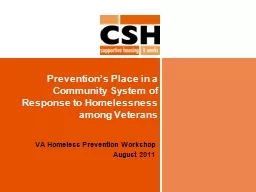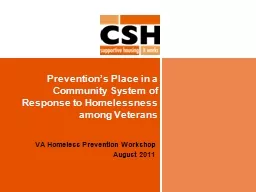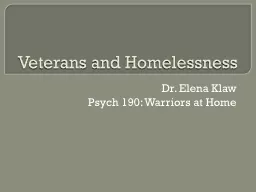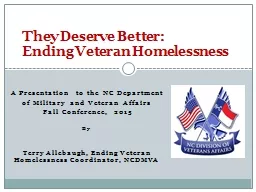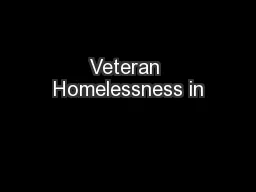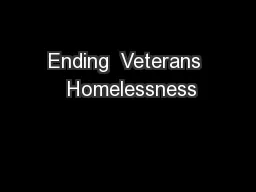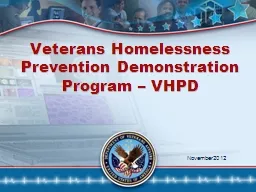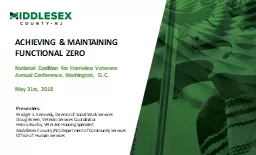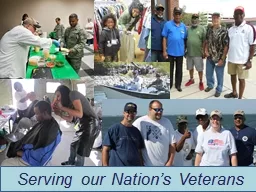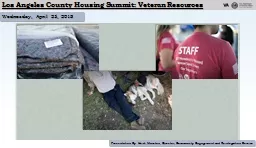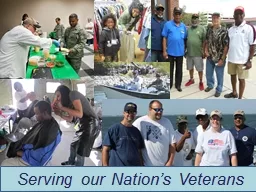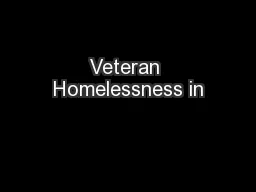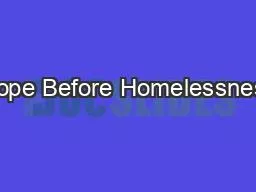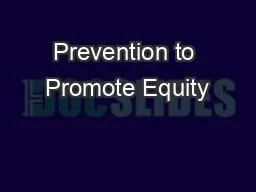PPT-Prevention’s Place in a Community System of Response to Homelessness among Veterans
Author : celsa-spraggs | Published Date : 2018-11-07
VA Homeless Prevention Workshop August 2011 Corporation for Supportive Housing CSH is a national nonprofit organization that helps communities create permanent housing
Presentation Embed Code
Download Presentation
Download Presentation The PPT/PDF document "Prevention’s Place in a Community Syst..." is the property of its rightful owner. Permission is granted to download and print the materials on this website for personal, non-commercial use only, and to display it on your personal computer provided you do not modify the materials and that you retain all copyright notices contained in the materials. By downloading content from our website, you accept the terms of this agreement.
Prevention’s Place in a Community System of Response to Homelessness among Veterans: Transcript
VA Homeless Prevention Workshop August 2011 Corporation for Supportive Housing CSH is a national nonprofit organization that helps communities create permanent housing with services to prevent and end homelessness . Secretary Shinseki’s Goal: . End Homelessness Among Veterans in . 5 . Years. “We will provide new help for homeless Veterans because those heroes have a home – it’s the country they served, the United States of America. And until we reach a day when not a single Veteran sleeps on the street our business is unfinished.”. VA Homeless Prevention Workshop. August 2011. Corporation for Supportive Housing. CSH is a national non-profit organization that helps communities create permanent housing with services to prevent and end homelessness. . Dr. Elena Klaw. Psych 190: Warriors at Home. Goals for Today. Risk factors for homelessness in vets. Rates of homelessness. Addressing risk factors. Based on what you have learned so far…. Why might veterans be at particular risk for homelessness?. of Military and Veteran Affairs. Fall . Conference, 2015. By . Terry . Allebaugh. , Ending Veteran Homelessness Coordinator, NCDMVA. They Deserve Better:. Ending Veteran Homelessness . “ensuring that individuals and families who become homeless return to permanent housing within 30 days.”. North Carolina. Jeffrey Doyle, LISW. Homeless Coordinator. VA Mid-Atlantic Health Care Network . NC Overview. HUD Point-in-Time Count. A national one day benchmark that is used as a data point for the number of homeless individuals in a community.. . 1. Larry “Bear” Weinzirl. Chairman. Presented By:. National . Veterans . Employment . and Education . Commission. 2. An Excellent Question. 3. Many veterans sacrifice comfortable, lucrative lives to protect the liberties of their home country . November. 2012. VHPD- Primary Responsibilities. Conduct outreach to locate eligible . veterans. Determine eligibility based on minimum service . requirement.. Partner with Vet Center, HUD grantee and . FUNCTIONAL ZERO. National Coalition for Homeless Veterans . Annual Conference, Washington, D.C.. May 31st, 2018 . Presenters:. Bridget S. Kennedy, Director of Social Work Services. Doug Breen, Veteran Services Coordinator. Elks National Veterans Service Commission. Ending Veteran Homelessness: How the Elks can Help . Elks National Convention. July 4, 2016. Our Mission . The Elks are committed to the mission, “. So long as there are veterans, the Benevolent and Protective Order of Elks will never forget them. Wednesday, April 25, 2018 . Presentation By: Heidi Marston, Director, Community Engagement and Reintegration Service. Community Engagement & Reintegration Service (CERS). Briefing Agenda:. Analysis: Rental Costs in Major Metropolitan Markets. Elks National Veterans Service Commission. Ending Veteran Homelessness: How the Elks can Help . Elks National Convention. July 4, 2016. Our Mission . The Elks are committed to the mission, “. So long as there are veterans, the Benevolent and Protective Order of Elks will never forget them. North Carolina. Jeffrey Doyle, LISW. Homeless Coordinator. VA Mid-Atlantic Health Care Network . NC Overview. HUD Point-in-Time Count. A national one day benchmark that is used as a data point for the number of homeless individuals in a community.. Daphne’ Adams. Family Programs Manager . My Reason. What made you choose this session?. Goals and Outcomes. View the increase in individuals and families experiencing homelessness.. Recognize that Homeless Prevention is more than just rental assistance.. HomelessSystemResponseWell-designed homelessness prevention that is centered around preventing homelessness or housing instability within the environmental and structural factors that result in the di
Download Document
Here is the link to download the presentation.
"Prevention’s Place in a Community System of Response to Homelessness among Veterans"The content belongs to its owner. You may download and print it for personal use, without modification, and keep all copyright notices. By downloading, you agree to these terms.
Related Documents

